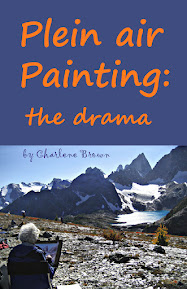Libyco-Punic Mausoleum and other newer ruins
watercolour and oil pastel
©2018 Charlene Brown
Dougga, located in northwestern Tunisia, is
considered to be the best preserved example of an Africo-Roman town in North
Africa.
I have rearranged and condensed the city in
this painting in order to fit the Libyco-Punic Mausoleum – the only monument of this type known in the ancient world – into the composition. It is the tall structure in the upper
right hand corner of the painting. Originally
built in the second century BCE when the area was a Phoenician colony, the
mausoleum had an important bilingual Numidian and Punic-Libyan inscription that
enabled archaeologists to decipher the original alphabet.











